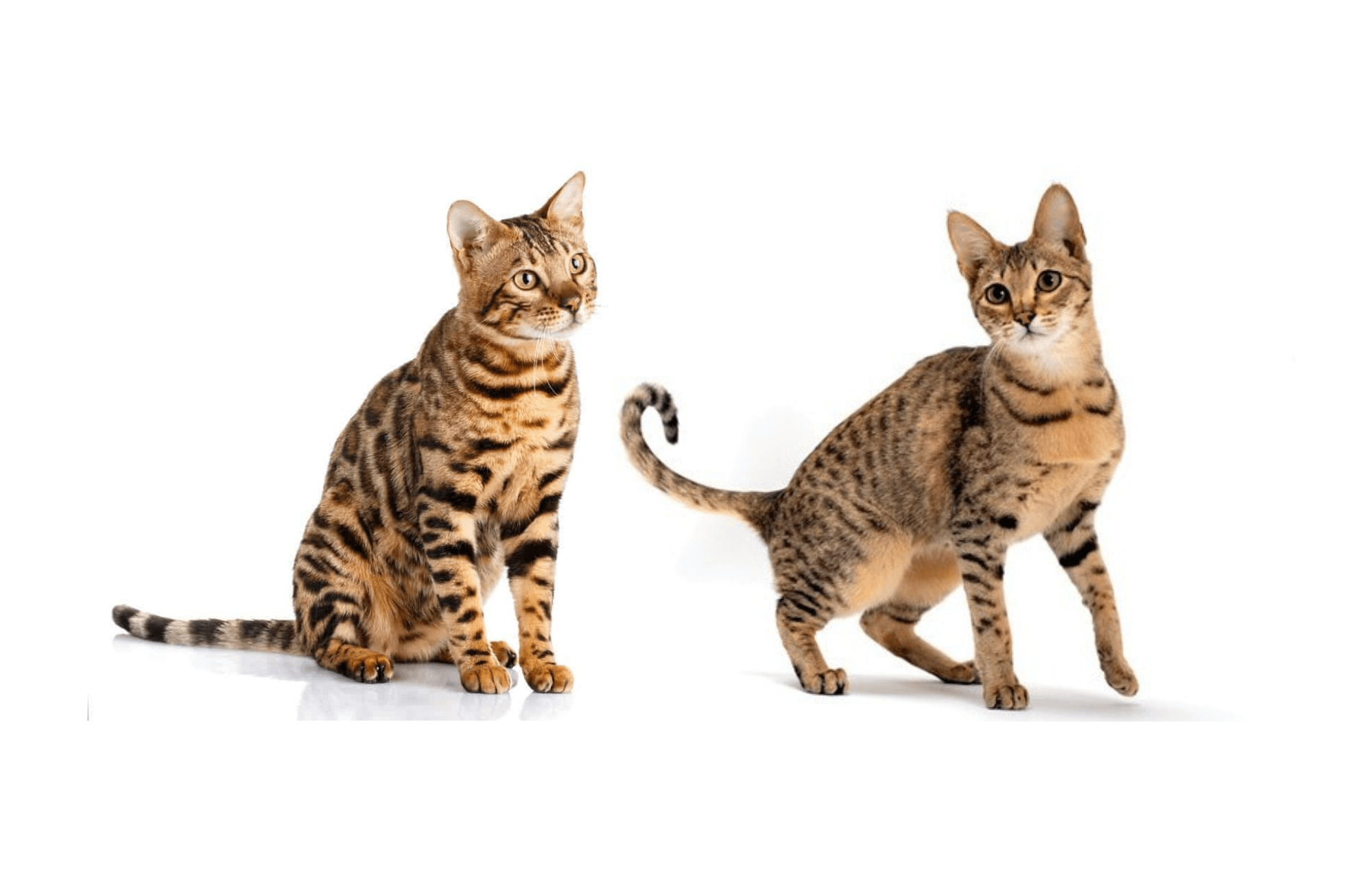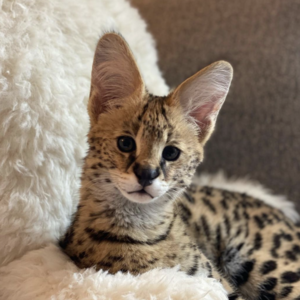The two most popular hybrid cat breeds in the world are bengal cats and savannah cats.
Bengal cats and savannah cats share several similarities between each other but also have their own, unique differences.
One of the obvious differences between savannah cats and bengal cats is the wild cat that they originate from.
While bengal cats are initially bred from the Asian leopard cat, savannah cats are bred from the Serval, creating a very different set of genetic backgrounds among these two cats.
What Are All the Differences Between Bengal Cats and Savannah Cats?
In addition to the key differences in genetic background, there are several dissimilarities between bengals and savannah cats.
The first main difference between the two is size.
Savannah cats are the largest domestic cat breed in the world and, on average, are twice the size of bengal cats.
Savannah cats can weigh up to 25 pounds as adults while adult bengal cats do not normally weigh more than 15 pounds.
Savannah cats are also usually 20 inches long as adults while bengals are only 15 inches long.
Another difference between savannah cats and bengal cats is their appearance.
Bengal cats have a striking appearance and tend to stand out due to their rosettes, sparkling fur, and exotic look.
Savannah cats, on the other hand, do not have rosettes since Servals are only spotted.
Savannah cats also have much longer hind legs and larger ears and look slightly more fierce in comparison to bengals.
A third difference between the two hybrids are their personalities.
Bengals and savannah cats do share some similar personality traits, such as being energetic, liking affection, and being very social.
Overall personality-wise, bengals are more extroverted and savannah cats tend to be slightly more reclusive and prefer their personal space a little more.
Bengals are more “lap cats” and savannah cats are slightly more like dogs – very loyal but they won’t necessarily shower you in constant affection.
Bengals are also more vocal and will likely tell you how they feel constantly. Savannah cats may be noisy at times as well, but do not communicate as often as a bengal cat might.
Of course, every cat is bound to be different based on their own unique personality and there are both bengals and savannah cats who have quirks and defy the stereotypes for their breed.
History of Bengal Cats
The first non-F1 bengal cat to ever be bred was by Jean Mill in 1963.
While Jean Mill was not responsible for the first ever bengal, she was the primary advocate of bengal cats in the 1960’s and was able to bring them into popularity by breeding them past the F3 generation, allowing them to be considered domestic cats.
More than 20 years after Jean Mill bred the first F4 bengal cat, the bengal cat breed was officially recognized by the International Cat Association (TICA) in 1986.
Bengal cats quickly gained the attention of cat lovers all over, and demand for bengals has been rising ever since with over 2,000 registered bengal cat breeders around the world and an estimated 500,000 – 1,200,000 bengals that now exist.
History of Savannah Cats
Savannah cats were first bred in the 1980’s by Judy Frank, however they did not catch on until a decade later in the 1990’s.
In 1996, after several years of breeding savannah cats, Patrick Kelley and Joyce Sroufe presented the savannah cat to the TICA as a new cat breed.
5 years later, the TICA accepted savannah cats as an official registered breed in 2001, however, savannahs had already begun their rise in popularity and were being bred and kept as pets around the world.
Currently, there are 52 savannah cat breeders in the world that are registered with TICA and 67 savannah cat breeders that are registered with the SCA, however there are likely many more breeders that are simply not included on these registries.
Are Savannah Cats Bigger Than Bengal Cats?
Generally, savannah cats are much bigger than bengals.
Savannah cats usually outweigh bengal cats by at least 5 pounds and are 2-4 inches taller.
Here is a side-by-side size comparison between bengal cats and savannah cats:
| Dimensions | Weight | Height | Length |
| Bengal Cat | 10 – 15 lbs | 13 – 16 inches | 14 – 18 inches |
| Savannah cat | 15 – 25 lbs | 14 – 18 inches | 18 – 23 inches |
Are Bengal Cats More Expensive Than Savannah Cats?
While both cats are rare, savannah cats have not existed as long as bengals have and are still being established as a domestic breed meaning there are less savannah breeders and less savannah cats available for purchase.
Since savannah cats are less common than bengals, they tend to cost significantly more.
The average price of a bengal kitten is around $1,500 – $3,000.
The average price of an F4 – F5 savannah kitten is $1,000 – $2,500, and the average price of an F1 savannah kitten can exceed $20,000 in some cases.
Here is a table from F3 Savannah Cat that shows the typical price ranges you might see for savannah kittens based on their filial generation:

Should you Buy a Savannah Cat or Bengal Cat?
To determine which cat is right for you, you will need to first decide which kind of cat you are looking for.
For a high energy, larger cat, the savannah cat is your best choice.
If you are more interested in a “miniature leopard” and prefer a cat that can fall asleep in your lap while keeping its exotic look, the bengal cat may be better for you.
The main determining factors for whether to buy a savannah cat or a bengal cat is if you have a cat size preference and whether you prefer the Asian leopard or Serval look more.
Both cats are awesome pets and are some of the most fun and playful cats in the world to own, so whichever cat you end up bringing into your home, you will undoubtedly be happy with your final decision.



max castle says:
I got a amazing F1 savannah cat! thank you for the tips
https://www.f1savannahkittens.com